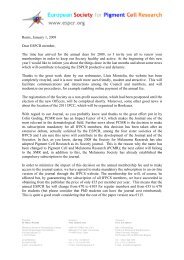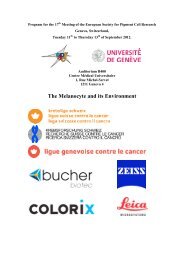espcrbulletin - European Society for Pigment Cell Research
espcrbulletin - European Society for Pigment Cell Research
espcrbulletin - European Society for Pigment Cell Research
Create successful ePaper yourself
Turn your PDF publications into a flip-book with our unique Google optimized e-Paper software.
Twenty-eight tetraketones (1-28) with variable substituents at C-7 were synthesized and evaluated<br />
as tyrosinase inhibitors. Remarkably compounds 25 (IC(50)=2.06muM), 11 (IC(50)=2.09muM),<br />
15 (IC(50)=2.61muM), and 27 (IC(50)=3.19muM) were found to be the most active compounds of<br />
the series, even better than both standards kojic acid (IC(50)=16.67muM) and l-mimosine<br />
(IC(50)=3.68muM). This study may lead to the discovery of therapeutically potent agents against<br />
clinically very important dermatological disorders including hyperpigmentation as well as skin<br />
melanoma.<br />
- Kim DS, Park SH, Kwon SB, Youn SW, Park ES, Park KC.<br />
Heat treatment decreases melanin synthesis via protein phosphatase 2 inactivation. <strong>Cell</strong><br />
Signal. 17(8):1023-31, 2005. Epub 2004 Dec 23.<br />
In the present study, we investigated the effects of heat treatment on melanogenesis in a mouse<br />
melanocyte cell line (Mel-Ab). It has been reported that activated extracellular signal-regulated<br />
kinase (ERK) is responsible <strong>for</strong> microphthalmia-associated transcription factor (MITF)<br />
degradation, which leads to a reduction in tyrosinase protein production and melanin synthesis.<br />
Here we demonstrate that heat treatment induces sustained ERK activation, which may inhibit<br />
melanogenesis. However, the specific ERK pathway inhibitors, PD98059 or U0126 did not restore<br />
heat-induced hypopigmentation. Furthermore, PD98059 or U0126 hardly blocked the heat-induced<br />
activation of ERK. These results suggest that heat treatment may inactivate protein phosphatase,<br />
and thus ERK activation is maintained. To support this hypothesis, we examined the effects of heat<br />
treatment on protein phosphatase 2A (PP2A) activity. The results obtained show that heat<br />
treatment inactivates PP2A, which may subsequently cause ERK activation and that heat treatment<br />
inhibits MITF promoter activity. Overall, our results demonstrate that heat treatment reduces<br />
melanin production in a temperature-dependent manner.<br />
- Kim HJ, Seo SH, Lee BG, Lee YS.<br />
Identification of tyrosinase inhibitors from Glycyrrhiza uralensis. Planta Med. 71(8):785-7,<br />
2005.<br />
Tyrosinase is a key enzyme in the production of melanins. Phytochemical studies of a Glycyrrhiza<br />
uralensis extract were per<strong>for</strong>med by measuring the tyrosinase and melanin synthesis inhibitory<br />
activity. Glycyrrhisoflavone and glyasperin C were identified as tyrosinase inhibitors <strong>for</strong> the first<br />
time. Glyasperin C showed a stronger tyrosinase inhibitory activity (IC (50) = 0.13 +/- 0.01<br />
microg/mL) than glabridin (IC (50) = 0.25 +/- 0.01 microg/mL) and a moderate inhibition of<br />
melanin production (17.65 +/- 8.8 % at 5 microg/mL). Glycyrrhisoflavone showed a strong<br />
melanin synthesis inhibitory activity (63.73 +/- 6.8 % inhibition at 5 microg/mL). These results<br />
suggest that glyasperin C and glycyrrhisoflavone could be promising candidates in the design of<br />
skin-whitening agents.<br />
- Kim YJ, Uyama H.<br />
Tyrosinase inhibitors from natural and synthetic sources: structure, inhibition mechanism<br />
and perspective <strong>for</strong> the future. <strong>Cell</strong> Mol Life Sci. 62(15):1707-23, 2005.<br />
Tyrosinase is known to be a key enzyme in melanin biosynthesis, involved in determining the color<br />
of mammalian skin and hair. Various dermatological disorders, such as melasma, age spots and<br />
sites of actinic damage, arise from the accumulation of an excessive level of epidermal<br />
pigmentation. In addition, unfavorable enzymatic browning of plant-derived foods by tyrosinase<br />
causes a decrease in nutritional quality and economic loss of food products. The inadequacy of<br />
current conventional techniques to prevent tyrosinase action encourages us to seek new potent<br />
tyrosinase inhibitors. This article overviews the various inhibitors obtained from natural and<br />
synthetic sources with their industrial importance.<br />
- Komarov DA, Slepneva IA, Glupov VV, Khramtsov VV.<br />
Superoxide and hydrogen peroxide <strong>for</strong>mation during enzymatic oxidation of DOPA by<br />
phenoloxidase. Free Radic Res. 39(8):853-8, 2005.<br />
1441







